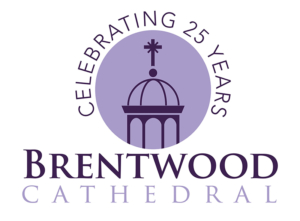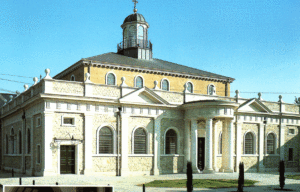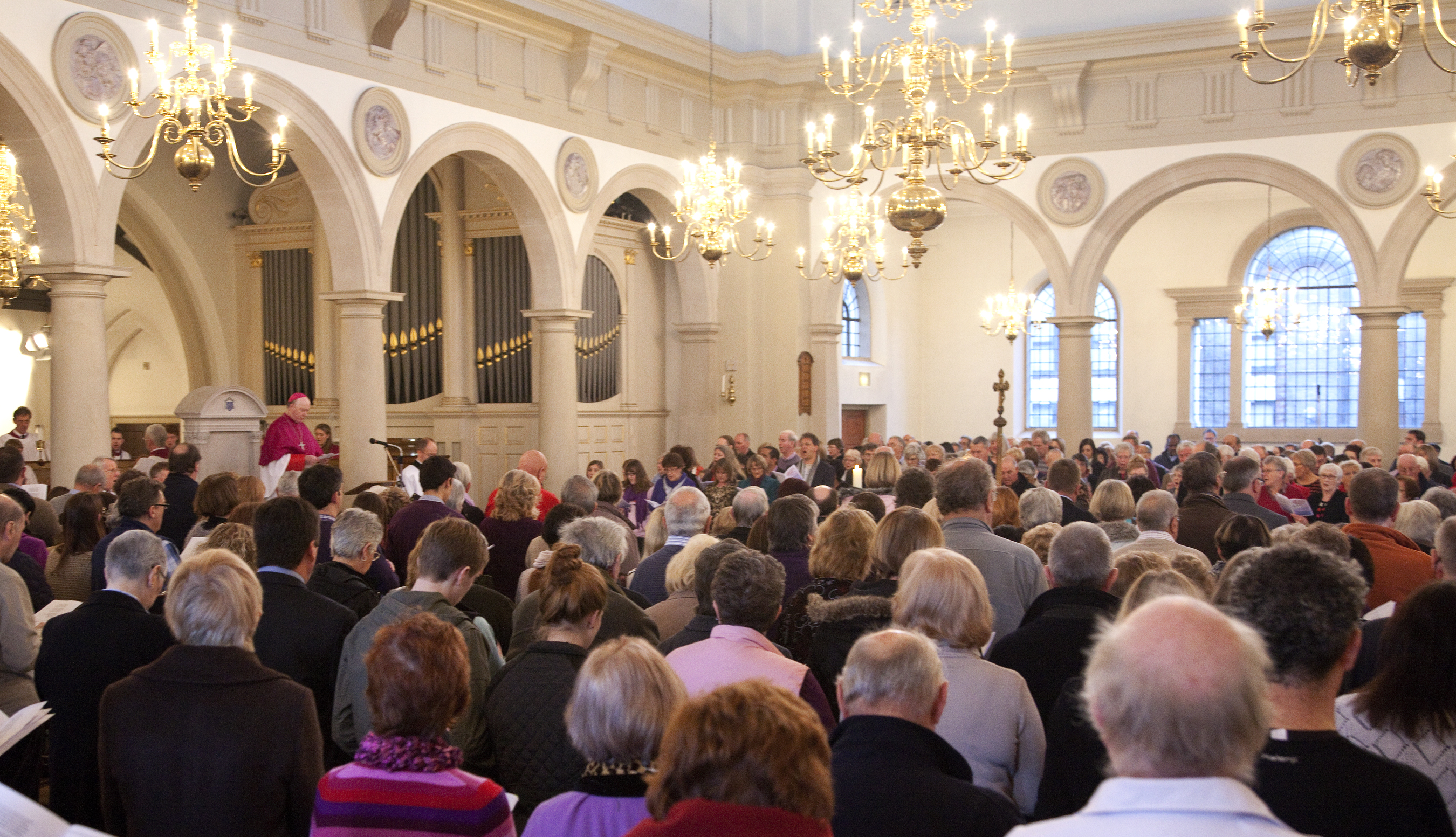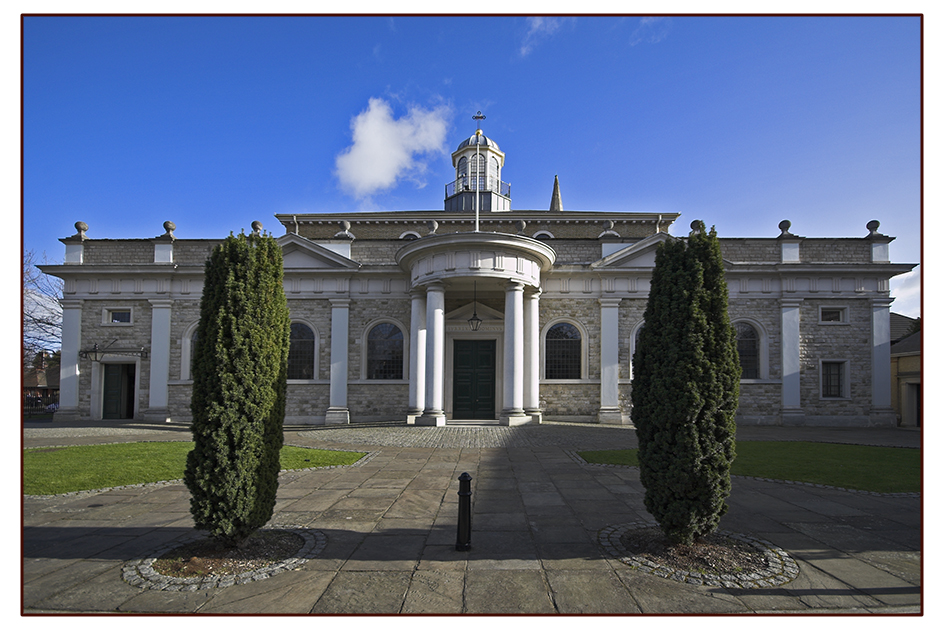
Cathedral celebrates Silver Jubilee
1991-2016
The New Brentwood Cathedral is 25 years old
This landmark will be celebrated at the end of May.
On Sunday 29 May 2016 it will be the turn of the Parish to celebrate with a special Choral Vespers at 4pm followed by a “Bring-and-Share” Tea Party in the Hall, during which there will be live music.
On Tuesday 31 May 2016 – the exact anniversary of the Dedication – there will be a Diocesan celebration with Bishop Alan Williams and Bishop Emeritus Thomas McMahon at 7pm.
25 years ago … the Rt Rev. Thomas McMahon, Bishop Emeritus of Brentwood wrote…
 Welcome to Brentwood Cathedral. A Cathedral takes its name from the Greek word for chair, Cathedra, from which the Bishop presides as shepherd of the diocese. The Cathedral is therefore the centre and mother church of the diocese. Brentwood Cathedral is also, in a very special way, the parish church of those who live nearby and who worship here each Sunday.
Welcome to Brentwood Cathedral. A Cathedral takes its name from the Greek word for chair, Cathedra, from which the Bishop presides as shepherd of the diocese. The Cathedral is therefore the centre and mother church of the diocese. Brentwood Cathedral is also, in a very special way, the parish church of those who live nearby and who worship here each Sunday.
Cathedrals were built to proclaim and celebrate the Christian mysteries in an environment of excellence and beauty, and so lift up the spirit. When we wish to express our experience of the sublimity of God, the most eloquent way is often in stone, music, colour, art, vestments – all enhancing worship and so combining to raise the heart and mind to God. In some way they supply a language to express what lies beyond words. A cathedral should try to offer the very best in these things for it is through beauty that we catch a glimpse of eternity.
The new Brentwood Cathedral was dedicated by Cardinal Hume on May 31st 1991. The donors chose to remain anonymous and the money was given solely for this purpose. The architect Quinlan Terry was commissioned to build the new church in the Classical style.
Architecturally, he took his inspiration from the early Italian Renaissance crossed with the English baroque of Christopher Wren. This, it was felt, would be appropriate for the town and its conservation area, but above all it would provide the right space and light for the liturgy to be celebrated.

BBC Essex Carol Service 16 Dec 2012
Work began in 1989 and was completed two years later. The north elevation consists of nine bays each divided by Doric pilasters. This is broken by a huge half-circular portico, which was inspired by a similar one at St Paul’s. If you stand just in front of it, you get some idea of its giant scale!
The Kentish ragstone walls have a natural rustic look, which contrasts with the smooth Portland stone of the capitals and column bases. The handmade traditional Smeed Dean brick of the clerestory leads up to the octagonal lantern, or cupola, the high point both of the outside and inside. It would be rare to find an ancient house, parish church, let alone a cathedral, that doesn’t have a blend of styles.
A conscious decision was taken to retain part of the Gothic revival church of 1861 alongside the new classical cathedral. The east elevation juxtaposes the old and the new, linking them through the scale of the 1991 building and the sympathetic use of ragstone and Welsh slate roof tiles.
Interior
All the Classical architectural orders are represented in the interior – the four giant Doric pilasters, the Tuscan arcade of arches, the Ionic pilasters of the Palladian windows in the east and west aisles, the Corinthian and Composite influences evident on the cathedral and the organ case.
While the interior of the cathedral has a deliberately ‘restrained’ feeling to it, richness is to be found in the ceiling. The Roman key pattern and the double guilloche pattern, picked out in gold leaf, are dominant here. All the round-headed windows are in the Classical-Wren style, with clear leaded lights of hand-made glass.
With clear windows on all four sides, the cathedral is flooded with light at any time of the day. This, together with the white walls and stone floor, combines to give a translucent effect which uplifts the spirit and conveys its own sense of the presence of God. The cathedral is lit by brass English Classical chandeliers (one of which was formerly in the church at Epping) and, above the cornice, concealed lighting.
The altar is the focal or high point (which is what the name means) of any church because it is the sign of Jesus Christ himself and the one eternal Sacrifice of Our Saviour. The processional cross is a copy of a medieval design. The figure represents a transitional period in the theology of design where Christ still wears the crown of the Risen Lord, but the corpus is that of the crucified Saviour.
The Bishop’s chair or cathedra is a tangible sign of his presiding over the diocese. He uses it also for presiding at the liturgy, a link with presiding chairs in parish churches throughout the diocese. It was made in Pisa, in Nabrassina stone, and has steps of Portland stone. In the centre is the coat of arms of the diocese. The base of the seat is inlaid with slate, to match the floor.
Consecration crosses are incised into the stone of the Doric pilasters that hold up the clerestory. They were anointed like the altar, as a sign that the whole building is dedicated to God. On the feast of the Dedication the candles in front of the gilded crosses are lit.
In the east aisle, there are two rooms set aside to celebrate the Sacrament of Reconciliation or Confession. Opposite them is a crucifix, formerly in the church at Stock, Essex.
Around the arcade are terracotta roundels representing the 15 Stations of the Cross. These were modelled by Raphael Maklouf, the well-known sculptor, who was responsible for the Queen’s head on all current coins. Their milky glaze perfectly complements the subtlety and intimacy with which the familiar scenes have been expressed.
Dedication
“Sermons in Stone”
Extracts from the Homily on the Occasion of the Dedication of the Cathedral by Cardinal Basil Hume O.S.B 31st May 1991
“Let me speak first in praise of cathedrals. One of the glories of our nation is that our land is rich in cathedrals, both ancient and modern, each one a song of praise in stone or in brick to the glory of God, to His magnificence and to His beauty.
“Our forefathers, strong in faith, knew instinctively that nothing but the best would ever be good enough for the adoration and worship of God, that fundamental duty of every creature. The most noble architecture, the best music, dignified ceremonies, each would contribute to raising our minds and hearts to God, each one put to the service of our prayer.
“Whether we frequent churches or not, they are important silent witnesses, sermons in stone reminding the passer-by of other values, those of the spirit. By their very presence they put into correct perspective all the human activity that goes on around them. Moreover, a church, and even more so a cathedral, must, as it were, be self-consciously proud of its own dignity and beauty, and attract attention.
“I believe that we were right, as we look around and see what has been achieved by the architect, to sing with the psalmist: “How lovely is your dwelling-place, Lord God of hosts.” I confess that I have allowed my eyes to wander, and that I did so with deliberation. The eyes, like the ears, are windows that admit shafts from the glory of God leading us to delight and wonder at that beauty which God is. I have looked and thanked God for what has been achieved here and for the inspiration which this cathedral will be for so many. My eyes fell too, “on those living stones which constitute the spiritual house” of God – all of you – “a chosen race, a royal priesthood, a consecrated nation, a people ,set apart” to sing the praises of God… St Peter was not indulging in charming exaggeration when he wrote these lines. He was just reminding the followers of Christ of their astonishing dignity – reborn in the waters of baptism, anointed with holy oil and so set apart for a holy purpose, offered incense out of respect for being temples of the Holy Spirit, much loved by that consuming love of God, which is for each one of us warm and intimate.
“Yes, we enjoy a great dignity in virtue of our Baptism, but that gift is for a purpose: first to praise God by all that we do, say and are, and secondly… to bring all nations to the fullness of truth. There is a job to be done. We are evangelisers, witnesses to the values of the Gospel, enthusiasts for God.
“When you hear the pealing of your new bell, Gabriel by name, remember that it announces a message to you and to future generations. “Go out into the world” – it says – “proclaim the Good News.” And may she who heeded that angel’s message at the very dawn of our Christian era intercede for all of you in this diocese of Brentwood and especially on this special day for you and for her.”
